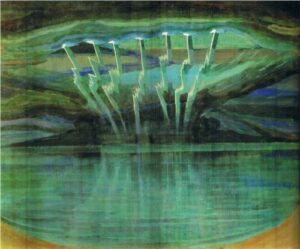These spells are inspired by confusion, disintegrate, slow, haste, growth of animals, neutralize poison, polymorph self, polymorph other, and stone to flesh. See spells without levels for more information about this project. The category name vivimancy was borrowed from The City of Iron.
Bloodlust
This spell awakens the inner beast, causing the growth of claws and fangs, granting a +1 to attack and damage, and a decrease by 1 to all damage taken (a saving throw is permitted for the unwilling). Any creature so enraged must make a melee attack against the nearest combatant every round in the most violent manner possible (this generally means that the target should be determined randomly). When the spell expires, the subject collapses into unconsciousness if a saving throw is failed, and if this saving throw is a natural 1, the subject contracts lycanthropy.
Genoplasm
The sorcerer’s touch causes the chaotic workings of life to permeate contiguous nonliving matter, approximately the size of one human per level (living creatures touched during the workings of this spell are subject to mutation if a saving throw is failed). One exploration turn of contact leads to softening and weakness, as veins, entrails, and other organic appurtenances metastasize, and after three exploration turns of contact, the matter collapses entirely into warm, pulsing slime. During each turn of contact, there is a 1 in 6 chance of the transforming matter spawning some hitherto unseen organism, though such spawns are almost certainly unviable.
Indolence
All within a melee area are stricken with lethargy, moving at half their normal rate, and acting last in initiative automatically. Creatures of less than or equal HD to the sorcerer’s level are affected automatically, while others get a saving throw to avoid the effect. Indolence may also be cast on mechanisms or other things that engage in progress or change.
Quickening
Similar to indolence, but the reverse in all ways.
Ravening
The growth processes of several animals are accelerated, inducing ravenous hunger. If sufficient food is not available, the creatures will attempt to consume anything nearby, and will gain sustenance from materials not normally consumable, such as wood or dirt, though food or flesh is preferred. The animals 1) double in size for the duration of the spell and then collapse into unconsciousness afterwards, 2) double in size permanently, or 3) grow until they become gargantuan and are driven insane.
Serpent’s Kiss
After casting this spell, the sorcerer grows long, hollow fangs, which may be used for a bite attack as if armed. These fangs may also be used to to draw out venom from someone that has been poisoned, negating the poison, though this process is painful and somewhat gruesome. Venom so extracted is then stored in a new gland that develops within the sorcerer’s body, and may be delivered by bite during the spell’s duration.
Totem
Every person has two totems, a predator totem and a prey totem, which are connected and should be determined randomly (and recorded): 1) bat/centipede, 2) cat/rat, 3) hawk/newt, 4) owl/frog, 5) serpent/chicken, 6) wolf/sheep. This spell allows the sorcerer to transform into the predator totem animal, or force another into their own prey totem (marked by the sorcerer’s totem sigil), the enchantment being permanent as long as the sigil is present (though a saving throw applies). Equipment does not transform.
Vitalize
A form in stone, such as a statue, is endowed with life, viscera, beating hearts, flesh, and so forth. If the stone was once living, that previous existence is permanently restored. Otherwise, when the spell ends the new life will 1) return to stone, 2) dissolve into a mess of biological waste, or 3) be stolen by an incorporeal soul, demon, or spirit for unpredictable purposes.

Redon – Flower of Blood (source)






